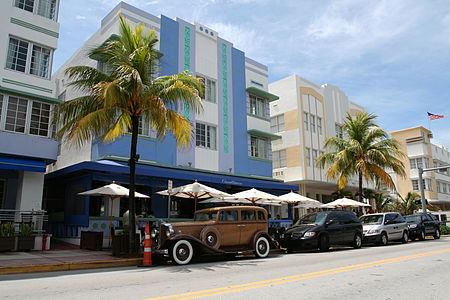Miami Beach Architectural District
Art Deco architecture in FloridaBuildings and structures in Miami Beach, FloridaGeography of Miami-Dade County, FloridaHistoric American Buildings Survey in FloridaHistoric districts on the National Register of Historic Places in Florida ... and 4 more
Miami Beach Architectural DistrictNRHP infobox with nocatNational Register of Historic Places in Miami-Dade County, FloridaUse mdy dates from August 2023

The Miami Beach Architectural District (also known as Old Miami Beach Historic District and the more popular term Miami Art Deco District) is a U.S. historic district (designated as such on May 14, 1979) located in the South Beach neighborhood of Miami Beach, Florida. The area is well known as the district where Italian fashion designer Gianni Versace lived and was assassinated by Andrew Cunanan, in a mansion on Ocean Drive. It is bounded by the Atlantic Ocean to the east, Sixth Street to the south, Alton Road to the west and the Collins Canal and Dade Boulevard to the north. It contains 960 historic buildings.
Excerpt from the Wikipedia article Miami Beach Architectural District (License: CC BY-SA 3.0, Authors, Images).Miami Beach Architectural District
Pennsylvania Avenue, Miami Beach
Geographical coordinates (GPS) Address Nearby Places Show on map
Geographical coordinates (GPS)
| Latitude | Longitude |
|---|---|
| N 25.785833333333 ° | E -80.134166666667 ° |
Address
Pennsylvania Avenue 1420
33139 Miami Beach
Florida, United States
Open on Google Maps










